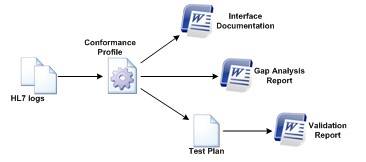We get this question a lot. Over the past few years, we’ve come up with a few answers. Let’s bring this full circle into 3 simple bullet points:
- A profile captures an interface specification. So profile = spec.
- Some people use the terms profile, spec, and specification interchangeably.
- Why build a profile? So that you save time building an interface and getting it into production.
Why build an HL7 profile?
- The profile or spec also gives you interface documentation you can share with your team or your client.
- The profile allows you to create a series of test scenarios – which in turn gives you a validation report.
- Profiles are the core of the interface lifecycle. And the core to getting interfacing work done faster, with fewer moving parts.
- That’s why profiles are a big part of our software.
The official HL7 International definition
We can also look at the formal definition of profile, introduced by HL7 International in the v2.5 specification. Here is an excerpt from section 2.12:
“An HL7 message profile is an unambiguous specification of one or more standard HL7 messages that have been analyzed for a particular use case. It prescribes a set of precise constraints upon one or more standard HL7 messages.”
In other words, a profile is a description of the data and messages that an interface sends and/or receives. The description covers:
- data format
- data semantics
- message acknowledgment responsibilities
The description must be clear and precise enough so that it can act as a set of requirements.
HL7 profiles make it easy to automate interface management
In the Caristix world, your HL7 profile gives you the ability to automate the production of:
- A gap analysis or mapping table between two systems. It’s much quicker to build the mapping table from profiles than by hand. It’s more accurate, too.
- Site-customized interface documentation. Customizing your documentation means support calls go faster, with much less back and forth.
- A test plan containing a series of validation tasks to automate your testing. This means you catch glitches before they go into production.
- A validation report for your testing. This means you can show that the work’s been done.

You can use the profile before the servers, the network connectivity, and the database configuration are set up.
Interface documentation
HL7.org uses the term “Conformance Statement” to cover conformance requirements. At Caristix, we prefer “Interface Documentation” because it doesn’t refer to a specific template or content. Whatever the term, your documentation should be flexible enough to contain whatever information is relevant to the project (and no more) so the documentation can flex with any integration project.
Gap analysis report
Using an HL7 profile, you’ll be able to map the differences between the profiles of the systems you need to connect. A Gap Analysis Report helps you document each difference or gap, providing a list of items the interface will have to address. These might include the data format, location or another requirement. For more on gap analysis, read the Caristix blog on gap types and how you go about performing a gap analysis.
Test plan and validation report
You can also use the HL7 profile to generate valid (and known invalid) HL7 messages so your newly configured interface can be tested automatically. When needed, the profile can help to test the data mapping defined in an interface engine. The profile can also help to validate that data semantics (the meaning of data) is consistent across the board.
HL7 profiles and automation
You can generate profiles and automatically create gap analyses, documentation, test plans, and validation reports using Caristix Workgroup software. Check out Part 1 of our on-demand webinar here:
http://youtu.be/uOBjjEpKLWY
The full 16-minute webinar
Like what you see in the intro above? The full webinar is available for viewing on-demand right now. Click this link to get to the full video.
For more information about Workgroup, visit the Workgroup product page.
